DeLorean time machine
In the Back to the Future franchise, the DeLorean time machine is a time travel device made by retrofitting a DMC DeLorean vehicle with a flux capacitor. The car requires 1.21 gigawatts of power and needs to travel 88 miles per hour (142 km/h) to initiate time travel. Universal Studios special effects department built three main DeLorean time machines for the movie Back to the Future. The film's producers characterized the DeLoreans with three names: the A car, B car, and C car. The "A" car, also known as the Hero car, was the most detailed and utilized vehicle during production.[1] After filming was over, the "A" car was delivered to Universal Studios Hollywood as an attraction piece. As time passed, visitors started taking parts off the vehicle and wandering off with them. Bob Gale selected a team to repair the car so it could be in a perfect condition. The vehicle is currently being displayed at the Petersen Automotive Museum in Los Angeles.[2]
| DeLorean time machine | |
|---|---|
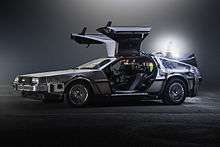 Side view of the DeLorean time machine | |
| Plot element from the Back to the Future franchise | |
| Publisher | Amblin Entertainment |
| First appearance | |
| Created by | Robert Zemeckis Bob Gale |
| Genre | Science fiction |
| In-story information | |
| Type | Time machine |
| Function | Allows the occupants to travel through time along with the car |
| Affiliation | Marty McFly Emmett Brown |
The "B" car, also known as Wreckage Car used in all three movies, was mainly used for stunts. After purposely being struck by a train during production, the car was left as a pile of rubble. Movie car customizer Jay Ohrberg used the "B" car wreckage to construct various DeLorean replicas. The "B" car's body panels were sold to Planet Hollywood Hawaii, where it was hooked up on the ceiling of the restaurant until its shutdown in 2010. The car was sold at auction to Bill and Patrick Shea after Back to the Future HQ reached out to Planet Hollywood to find the car's remains. The stunt car is currently being displayed at Hubbardston, Massachusetts.[3][4][5]
The "C" car was used for interior footage and was torn apart so the camera could fit inside the car. The vehicle was left at Universal Studios Hollywood, many of its parts were put together on a replica remodeled by Tom Talmon Studios for Universal Japan. Universal Japan sold the car to a private company and the vehicle it's currently displaying on the company's entryway.[4]
There were three extra DeLoreans used through the production of the sequels. The fiberglass car used on special effects was reportedly destroyed. The stunt train, better known as The Oxnard Car, was displayed in Universal Studios, Florida, from the early 1990s to 2020. The studio decided to replace the original car with a replica to be stored for restoration. The desert car with the blue cross over tube was left at Universal Studios Hollywood; Tom Talmon Studios used parts of this car on a replica displayed on Universal Japan. After Japanese workers stole some of the car props, ScreenUsed acquired the car for restoration and then settled the car for auction. Bill and Patrick Shea ended up buying it, and they placed the car on display at Hubbardston, Massachusetts.[3][5]
Operation
The control of the time machine is the same in all three films. The operator is seated inside the DeLorean (except the first time, when a remote control is used), and turns on the time circuits, activating a unit containing multiple fourteen- and seven-segment displays that show the destination (red), present (green), and last time departed (yellow) dates and times. After entering a target date with the keypad inside the DeLorean, the operator accelerates the car to 88 miles per hour (141.6 km/h), which activates the flux capacitor. As it accelerates, several coils around the body glow blue/white while a burst of light appears in front of it. Surrounded by electrical current similar to a Tesla coil, the whole car vanishes in a flash of white/blue light seconds later, leaving a pair of fiery tire tracks. A digital speedometer is attached to the dashboard so that the operator can accurately gauge the car's speed. Various proposals have been brought forth in the past by fans of the movie franchise for why the car has to be moving at 88 mph to achieve temporal displacement,[6] but actually the production crew chose the velocity simply because they liked how it looked on the speedometer, modified for the movie.[6] The actual speedometer on the production DeLorean's dashboard only goes up to 85 mph, and the car itself was criticized for being under-powered.
Observers outside the vehicle see an implosion of plasma as the vehicle disappears, leaving behind a trail of fire aligned with the DeLorean's tires, while occupants within the vehicle see a quick flash of light and instantaneously arrive at the target time in the same spatial location (relative to the Earth) as when it departed. In the destination time, immediately before the car's arrival, three large and loud flashes occur at the point from which the car emerges from its time travel. After the trip, the exterior of the DeLorean is extremely cold, and frost forms from atmospheric moisture all over the car's body. Thermal heaters on the back of the vehicle, as shown on right, heat the vehicle after time travel.
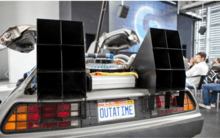
A few technical glitches with the DeLorean hinder time travel for its users. In the first film, the car has starter problems and has a hard time restarting once stopped, much to Marty's repeated frustration.[7] In the second movie, the destination time display malfunctions and shows random dates (mostly January 1, 1885), which partially cause Doc to be sent to 1885.[8] In the third movie, the flying circuits (added by Doc in 2015), fuel line, and fuel injection manifold are damaged, preventing the car from moving under its own power.[9]
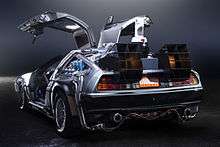
The time machine is electric and requires a power input of 1.21 gigawatts (1,620,000 hp) to operate, originally provided by a plutonium-fueled nuclear reactor.[7] In the first movie, Doc has no access to plutonium in 1955, so he outfits the car with a large pole and hook in order to channel the power of a lightning bolt into the flux capacitor and send Marty back to 1985.[7] During Doc's first visit to 2015, he has the machine refitted to hover above ground in addition to standard road driving, and he replaces the nuclear reactor with a Mr. Fusion generator that uses garbage as fuel.[7][8]
Although the Mr. Fusion unit provides the required power for the time machine, the DeLorean is still powered by an internal combustion engine for propulsion. The fuel line is damaged during Marty's trip to 1885 in Back to the Future Part III; after he and Doc patch it, they attempt to use whiskey as a replacement fuel since commercial gasoline is not yet available. The test fails, damaging the car's fuel injection manifold and leaving it unable to travel under its own power.
Doc and Marty consider options to reach the required 88 mph (such as pulling it with horses, which fails because the car barely breaks 30 mph) but ultimately settle on pushing the car with a steam locomotive. For the extra power needed to push the DeLorean up to speed, Doc adds his own version of "Presto Logs" (a chemically treated mixture of pressed wood and anthracite) to the locomotive's boiler and chooses a location with a straight section of track long enough to achieve 88 mph.[9]
The power required is pronounced in the film as one point twenty-one "jigowatts".[7] While the closed-captioning in home video versions spells the word as it appears in the script, jigowatt,[10] the actual spelling matches the standard prefix and the term for power of "one billion watts": gigawatt. Although rarely used, the "j" sound at the beginning of the SI prefix "giga-" is an acceptable pronunciation for "gigawatt."[11][12] In the DVD commentary for Back to the Future, Bob Gale states that he had thought it was pronounced this way because it was how a scientific adviser for the film pronounced it.[13]
Equipment
Flux Capacitor

The flux capacitor, which consists of a rectangular-shaped compartment with three flashing Geissler-style tubes arranged in a "Y" configuration, is described by Doc as "what makes time travel possible." The device is the core component of the time machine.[7]
As the time machine nears 88 mph, light coming from the flux capacitor begins pulsing more rapidly until it becomes a steady stream. Doc originally conceived the idea for the flux capacitor on November 5, 1955, when he slipped on the edge of his toilet while hanging a clock in his bathroom and hit his head on the sink.[7] A similar, but possibly steam-powered, flux capacitor is also seen in the chimney headlamp of Doc's second time machine, the Time Train, at the end of Back to the Future Part III.[9]
Although the films do not describe exactly how the flux capacitor works, Doc mentions at one point that the stainless steel body of the DeLorean has a direct and influential effect on the "flux dispersal", but he is interrupted before he can finish the explanation.[7] The flux capacitor requires 1.21 gigawatts of electrical power to operate, which is roughly equivalent to the power produced by 15 typical commercial airplane jet engines.
The instruction manual for the AMT/ERTL DeLorean model kit says: "Because the car's stainless steel body improves the flux dispersal generated by the flux capacitor, and this in turn allows the vehicle smooth passage through the space-time continuum."
Time Circuits
The time circuits are an integral part of the DeLorean time machine. They were built with an input device and a display. The display was divided into three sections: destination time (shown in red), present time (shown in green), and last time departed (shown in yellow), all annotated with Dymo labels. Each display includes a month, a day, a year, and the hour and minutes in that point in time. The years on the time circuits were limited to four digits and there were no possible negative years that could be reached, i.e. years before 1 A.D. This means the DeLorean could travel to any time from 12:00 am on January 1, A.D. 1 to 11:59 p.m. on December 31, A.D. 9999. It is unknown what would happen if one were to travel to the latter date since, after only one minute, it would be the year A.D. 10000 and the time circuits would no longer be able to show the present time.
The destination time display shows the date that the operator wants the DeLorean to go to (when the operator types in a date using the keypad in the DeLorean, it will be shown in the destination time display), the present time display shows the DeLorean's current location in time, and the last time departed display shows what point in time the DeLorean originally was after making a journey through time. Doc demonstrated its capabilities to Marty after its first test, giving three well-known but erroneous dates as examples: the signing of the Declaration of Independence, July 4, 1776; the birth of Christ, December 25, 0000; and the day that he invented time travel, November 5, 1955.
During the second film, the time circuits began malfunctioning, displaying January 1, 1885 in the destination time display. A bolt of lightning triggered the malfunction to send the DeLorean from 1955 to 1885. Though the vehicle was in mid-air, the spin created by the lightning bolt allowed it to reach 88 mph. Doc was trapped in 1885 and repairs were impossible because the time circuit control microchip, which powered the time circuits, was destroyed by the lightning bolt, and suitable replacement parts would not be invented until at least 1947. Doc placed repair instructions and a schematic diagram in the time machine to enable his 1955 counterpart to repair it using components from that era — which included vacuum tubes — before burying it in a mine, and sending Marty a letter via several generations of the Western Union.
Mr. Fusion

The Mr. Fusion Home Energy Reactor is the name of a power source used by the DeLorean time machine in the Back to the Future trilogy. It can be seen for the first time at the end of Back to the Future when "Doc" Emmett Brown pulls into the McFly's driveway after a trip to the year 2015. It is a parody of Mr. Coffee machines, which were very popular at the time of filming.[14] The appliance from which the prop was made was actually a Krups "Coffina" model coffee grinder.
The Mr. Fusion Home Energy Reactor converts household waste to power for the time machine's flux capacitor and time circuits using nuclear fusion, presumably cold fusion. In the film, Mr. Fusion allows the DeLorean time machine to generate the required 1.21 gigawatts needed to travel to any point in time. The energy produced by Mr. Fusion replaces plutonium as the primary power source of the DeLorean's time travel, allowing the characters to bypass the arduous power-generation requirements upon which the plot of the first film hinges. The plutonium fission reactor was most likely left installed underneath Mr. Fusion as a backup power source.[7][8]
The Mr. Fusion can provide enough power to the flux capacitor and the time circuits, but is not used to power up the DeLorean itself, which makes use of an ordinary gasoline combustion engine to reach the 88 mph speed necessary for it to time travel, a limitation that proved itself crucial in the third movie when Doc and Marty find themselves stuck in 1885 and unable to return with the DeLorean out of gas (due to a fuel leak). The vehicle's hover system is powered by Mr. Fusion and is capable of bringing the DeLorean up to the required 88 mph; the combustion engine was also probably left on board as a backup. However, the flight systems were destroyed as a result of a lightning strike, leaving Marty to rely on the original combustion engine, which in turn was disabled.
Fictional timeline
For most of the first film, the 1.21 gigawatts are supplied by a plutonium-powered nuclear fission reactor and, with the absence of plutonium, a bolt of lightning channeled directly into the flux capacitor by a long pole and hook in the film's climactic sequence.[7] At the end of the first film, and for the remainder of the trilogy, the plutonium nuclear reactor is replaced by a "Mr. Fusion Home Energy Reactor" generator possibly acquired in 2015.[8] The "Mr. Fusion" device apparently converts household waste into electrical power; the name suggests nuclear fusion. Due to a "hover conversion" made in 2015, the car also becomes capable of hovering and flight, though it lost this ability at the end of the second film.[8][9]
Following its creation, Doc tests it out by using a remote control to send it one minute into the future with his dog Einstein in it. Marty later uses the DeLorean to flee from Libyan terrorists and is transported to 1955 after accidentally activating the time circuits, but without the plutonium that is needed to power it. Because plutonium is not yet available in 1955, Marty and 1955 Doc decide to harness the power of a lightning strike that will happen one week later to power the flux capacitor. The plan succeeds, sending the DeLorean back to 1985 with Marty. Doc later uses it to travel to October 21, 2015, but briefly returns to 1985 to pick up Marty and get him to help stop his future son from committing a crime. While there, the DeLorean is stolen by Biff, who then travels back to November 12, 1955, the same day as the climax of the first film, to give his past self a sports almanac to be used for gambling. Once Biff returns to 2015 without Doc's knowledge, the duo return to 1985, but find themselves in an alternate timeline where Hill Valley is ruled by Biff that Doc described as 1985A (alternate 1985). The DeLorean then travels back to 1955 to restore the timeline,[8] but in the aftermath, it is struck by lightning again in the very same electrical storm, this time by accident. According to writers Bob Gale and Robert Zemeckis, the lightning causes the DeLorean to spin at 88 miles per hour,[15] and Doc later states in a letter to Marty that the bolt caused a "gigawatt overload" which "shorted out the time circuits and destroyed the flying circuits".[9] The DeLorean then disappears from 1955, travelling back in time to January 1, 1885 (earlier in the film, Doc mentions that the time circuits are not functioning correctly; several instances in the film that show the destination time circuit displaying January 1, 1885 as the destination when the time circuits malfunctioned).[8]
Once in 1885, the DeLorean is hidden in a mine because suitable replacement parts to replace its destroyed microchip will not be invented until 1947 (presumably referring to the transistor, invented in that year). 1955 Doc and Marty recover the DeLorean from the mine in 1955, and Doc builds a vacuum tube circuit assembly to replace the destroyed microchip circuitry and restore the vehicle's time travel capabilities. The tires have disintegrated in storage, so Doc replaces them with whitewalls. The gasoline engine is still functional, but the flying circuits are not.
Due to the events in all three films, a total of four DeLoreans exist at the same time in 1955: the first in 1955 Doc's lab (taking place during the events of the first film), the second hidden somewhere by 2015 Biff after stealing the DeLorean in 2015, the third used by Doc and Marty to travel to 1955 and undo the changes caused by 2015 Biff, and the fourth hidden in the mine after Doc is transported to 1885.
In a letter Doc wrote to Marty in 1885, Doc states he is happy in his new life there and requests that Marty not attempt to retrieve him, but instead to return to 1985 and destroy the DeLorean, believing that it has brought them and the world nothing but disaster. However, Marty and the Doc of 1955 learn of tragedy to come Doc's way when he is murdered by Biff's grandfather, Buford "Mad Dog" Tannen, on September 7, 1885; therefore, 1955 Doc agrees to send Marty back to the Old West to rescue himself. This resulted in two DeLoreans existing in 1885: the one hidden in the mine after Doc is sent to 1885 by the lightning strike, and the one that Marty uses to travel to 1885 to rescue Doc.
When Marty arrives in 1885, the DeLorean's fuel line is pierced by an arrow during an Indian attack. He and Doc patch it and attempt to use whiskey as a replacement fuel, since commercial gasoline is not yet available; the test fails, destroying the fuel injection and ignition systems and leaving the car unable to travel under its own power. They try using horses as an alternate means to get the car up to 88 mph, but this fails since the horses can't run more than 30 mph. Its final trip, from 1885 to 1985, is propelled by a steam locomotive that has Doc's version of "Presto Logs" (pressed wood treated with anthracite) added to the boiler to provide the extra power needed to push the car up to 88 mph while moving on a straight track with a flat level grade; once this speed is reached, the Mr. Fusion unit provides the power required to activate the flux capacitor and make the jump through time.[9] Doc replaces the 1955-style wheels with cast iron train wheels that fit on the track rails. He uses the old tires and a wooden support to cushion the locomotive's "cow catcher" and the car's rear end. Since each of the three "Presto Logs" fire at different intervals with increasing power, Doc installs a boiler temperature gauge on the DeLorean's dashboard to indicate when the car will experience a sudden burst of acceleration.
Once the DeLorean makes its final trip from 1885, it arrives back in 1985 and is immediately destroyed by an oncoming freight train running in the opposite direction. Marty is able to bail out of the car seconds before the train strikes. Later, the Time Train, which is Doc's second time machine, appeared in the same spot where the DeLorean was destroyed. At the end of the film, the Time Train departs to an unknown time with Doc's family.
Other elements
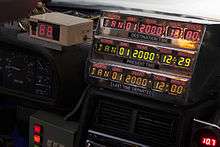
In the films, the DeLorean time machine is a licensed, registered vehicle in the state of California, where the films take place. The vanity license plate used in the film reads "OUTATIME", a deliberate anomaly, as the maximum number of symbols on California plates is seven characters.[7] When Doc returns from 2015, it is a barcode license plate,[7][8] which implies that by that year license plates have moved to other more sophisticated means of tracking and registering. There is also an alarm clock that sits in the cockpit (having been placed there by 1955 Doc in the first movie), which is set to ring when it is time for Marty to speed towards the clock tower to return to 1985. The clock remains in the DeLorean for the rest of the series.
In The Animated Series, Doc builds another DeLorean into a time machine, restoring most of its features, including Mr. Fusion and the hover conversion (Doc either rebuilds the one destroyed at the end of Part III or he simply builds a new one). He also seemingly adds the capability to travel through space in addition to time (i.e., appear at a different location from the one it departed), similar to the TARDIS from Doctor Who. The cartoon DeLorean time machine has many add-ons, including a back seat in normal two-door mode, the ability to transform into a four-door, a pop-out covered wagon top, a blimp, a rear video screen, and a voice activated time input.
Back to the Future: The Game features a chronal duplicate of the original DeLorean, which Doc Brown recovered from the timestream after the destruction of the original. This DeLorean is created at the end of Back to the Future Part II, when the original time machine was struck by lightning: while the DeLorean itself is sent to 1885, a fully functional duplicate appears (apparently unmanned and undamaged) in 2025, where Doc retrieves it with the Time Train. He later traveled to 1931 and sent the Clone DeLorean to 1986 to get Marty to rescue him from 1931 before he can be killed. This Clone DeLorean is effectively the same as the Part II one, including the occasional glitches in the time circuits (mostly affecting the last time departed time display), but with a new automatic retrieval feature that automatically brings the Clone DeLorean to a set time and location of Doc's choosing every time Doc Brown doesn't return to the car in a fixed amount of time.[16]
This DeLorean is later badly damaged (after returning to 1986, Marty crashes the Clone DeLorean into a billboard and after Marty gets out, the Clone DeLorean falls through the billboard and crashes onto the ground) and then restored by an alternate version of Doc Brown who has never developed time travel technology, having access to limited notes about the flux capacitor. As such, the time circuits of the alternate Clone DeLorean become even more glitchy following their return to 1931, accumulating errors as severe as the interval of time traveled, with increasing damage with every attempt: as such, Citizen Brown, the alternate version of Doc, has to install a diagnostic console made of materials available in 1931 (appearing as a plywood box with a lightbulb and three similar bulbs placed on the coils on the outer body).[17]
Apparently, part of the problem is chromium parts becoming unstable during time travel, according to Citizen Brown. This DeLorean is later stolen by Edna Strickland, one of the game's main villains. The original Doc arrives in the original Clone DeLorean as Citizen Brown disappears from existence due to earlier events in the game; i.e., because Marty restored the original timeline, the original Clone DeLorean was brought back into existence. Officer Danny Parker nearly arrests Marty and Doc for allegedly having the car that Edna got away in. After they explain to him that there is more than one DeLorean, Marty explains to Doc that the alternate Clone DeLorean had malfunctioning time circuits. To make matters worse, the entire town of Hill Valley disappears around them; Edna had unwillingly time traveled to 1876. They go to "Mary Pickford's" house and see that the alternate Clone DeLorean had been destroyed. After they get information from Mary, who was really Edna, they go to 1876. After they stop the fire that would've burned down Hill Valley, they chase down Edna, who is trying to get away in the alternate Clone DeLorean. Marty hoverboards to Edna's DeLorean and synchronizes the two DeLoreans by attaching signal dishes called flux synchronizers over the diagnostic lightbulbs on Edna's DeLorean and pointing them at the receiving dish on Doc's DeLorean, which is flying behind the one that Edna is driving. They all travel back to 1931, with Edna's DeLorean vanishing because of the time ripples catching up with them, causing "chronal decay" (i.e., since Citizen Brown's timeline ceased to exist, the alternate Clone DeLorean was erased from existence). Marty and Doc return to 1986, where three DeLoreans (one normal, one blue, and one black) suddenly arrive with different versions of Marty. The duo leave the Martys arguing before departing to an unknown time in their own DeLorean.[18]
It is implied that the Time Train stays with Clara, Jules and Verne, passingly mentioned as enjoying the same nomadic life around the time-stream of Doc, but it is never seen in the game. The ending introduces a blue DeLorean and a black DeLorean, but it is unknown how these DeLoreans were created.[16][18]
In Back to the Future: The Ride, Doc, who now lives in a lab called the Institute of Future Technology, had created an 8-passenger DeLorean that can fly just like the original DeLorean (which can be seen in the ride and in the outside display) and the Time Train (which can only be seen in display outside of the attraction). Unlike the original DeLorean, the flux capacitor is in the front of the cockpit along with a small screen, the time circuits, and the speedometer. The original DeLorean is equipped with a sub-ether time-tracking scanner that allows Doc to pinpoint its location in time. It is also shown to have its original "OUTATIME" license plate instead of the bar code license plate, but it could just mean that this DeLorean is actually a new one being built into a time machine. In the attraction, Biff Tannan (who stowed away in one of the institute's time machines that had recently visited 1955) steals the original DeLorean, prompting Doc to send the riders to the 8-passenger DeLorean and use it to go after Biff. After following Biff to 2015 Hill Valley, the Ice Age (where the 8-passenger DeLorean experiences a temporally engine failure), and the Cretaceous Period, Biff's DeLorean gets damaged by a T-Rex and lands in a volcano. The 8-passenger DeLorean follows Biff and bumps into him after both DeLoreans go over a cliff, sending them back to 1991. In a post-credits scene, Clara Clayton, who has built the Time Train with Doc, reveals to have currently repaired the DeLorean and travels back to 1947 to a farm.
In Doc Brown Saves the World, there was a repaired DeLorean time machine which included new replacement parts from 2015. The DeLorean is also seen in a video promoting Doc Brown Saves the World, and it is unknown as to whether or not a flux capacitor was inside.
Time Train
The Time Train was a second time machine that appears at the end of Part III, which is powered by steam instead of gasoline. Doc built it out of a steam locomotive (most likely a different one that Doc either purchased or stole since the one that Marty and Doc used to push the DeLorean up to 88 mph was destroyed). It took Doc ten years to build it. The flux capacitor is still included in this design, in the place of the lamp at the front of the locomotive. The time circuits appear as rotating dials that are identical to the DeLorean's time circuits, though are not clearly seen in the film. The sides of the cabin (which display Doc's initials: ELB) are capable of opening the same way as the DeLorean's gullwing doors, but can also deploy stairs that allow people to climb on board. How Doc was able to create the flux capacitor and time circuits for the Time Train in 1885 is unexplained, but it is assumed that Doc used parts from the hoverboard that Marty left behind in 1885 and the broken DeLorean that was buried in the mine to build them (it is also implied that Doc may have brought replacement parts from the future back to 1885, which he left with the broken DeLorean to ensure that Marty and his 1955 counterpart would be able to repair it). Unlike the DeLorean, the external components of the Time Train were symmetrical on both sides of the vehicle, possibly representing a more sophisticated grasp of the time travel technology on Doc's part, despite being constructed from more primitive materials. Interestingly, before the Time Train appeared in 1985, it triggered the bells and gates on the nearby railroad crossing as if another train was coming. This could mean that the Time Train is so powerful that it enables a connection with its destination time even before arriving to that point of time.
Following its completion and its first time travel test, Doc and his family traveled to 2015 and beyond to give it a hover conversion, allowing it to fly just like the DeLorean. When Doc returned 1985 to pick up Einstein and meet up with Marty and Jennifer, he chose the most likely place that they might be at that given time, the site of the DeLorean's destruction. After introducing his sons, Jules and Verne, and giving Marty a picture of him and Doc in 1885, Doc activates the train's flying capabilities and departs to an unknown time.
Behind the scenes
Development

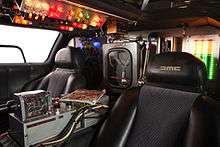
The time machine went through several variations during production of the first film, Back to the Future. In the first draft of the screenplay, the time machine was a laser device that was housed in a room. At the end of the first draft the device was attached to a refrigerator and taken to a nuclear bomb test. Director Robert Zemeckis said in an interview that the idea was scrapped because he did not want children to start climbing into refrigerators and getting trapped inside. In the third draft of the film the time machine was a car, as Zemeckis reasoned that if you were going to make a time machine, you would want it to be mobile.[19] The specific choice of vehicle was a DeLorean for the purposes of it looking like an alien spaceship[20] due to its characteristic gullwing doors (which were inspired by the Mercedes-Benz 300 SL). The original ending of the 1985 film Back to the Future was to have Marty outrun a nuclear explosion at a test site to power the DeLorean's flux capacitor in order to travel back to 1985. However, during the movie's filming, it went overbudget and behind schedule, and Universal refused to grant the producers any more money, as it couldn't afford the desert location to shoot such scenario. Ultimately, the power source was changed to the lightning strike at the clock tower in Hill Valley as a result.[21]
When the filmmakers arrived at the point where the time machine would be built into a car, the art department was instructed to come up with designs for the DeLorean. Andrew Probert was the first artist to explore the subject (before Ron Cobb joined the production), but his designs were deemed "too perfect" for the look the producers wanted, which was to make it look as if it had been built in a garage by Doc Brown. The idea was that it had been constructed with parts found in a hardware and electronics store, so it couldn't look too sophisticated. It also had to look dangerous, as Producer Bob Gale noted in the DVD commentary for Back to the Future.[20] The task was undertaken by Ron Cobb who added the coils to the back of the vehicle. The nuclear reactor was also a design choice made by Cobb. This choice proved to be important, given the direction the script had taken. Cobb complemented the nuclear reactor with one vent on the back of the car, since it was generally known at the time that nuclear reactors had vents. Once Cobb had left the production, the producers wanted to balance the design with another vent, keeping a symmetrical aesthetic. Probert was asked to step in and he brought the design to its final form. At the end of the first film of the trilogy these vents become the propulsion system for the improved DeLorean, which now had hovering abilities and could reach the time-traveling speed of 88 miles per hour flying. The production design team added other buttons and lights inside the car to make it look more appealing and complex in order for the audience to have something attractive to look at.
Different parts from three 1982 DeLoreans were used in the first film. Liquid nitrogen was poured onto the car for scenes after it had travelled through time to give the impression that it was cold. The base for the nuclear reactor was made from the hubcap from a Dodge Polara. Aircraft parts and blinking lights were added for effect. In one of the first scenes, carbon dioxide extinguishers were hidden inside the DeLorean to simulate the exhaust effect.[22] Ultimately, five real DeLoreans were used in the filming of the trilogy, plus one "process" car built for interior shots. In the off-road scenes in the third film, a modified-for-off-road VW Beetle frame was fitted to the DeLorean with the whitewall tires and baby Moon hubcaps.[23] A seventh DeLorean was also used in the filming; however, this one was merely a full-sized, fiberglass model used for exterior shots where the vehicle hovers above the set as well as when the actors interact with the vehicle.[24]
Rather than use the sound of the stock V-6 DeLorean engine in the film, the sound of a DeLorean with a Legend Twin Turbo VIN 530 was used.
Replicas
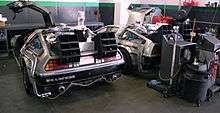
A number of private auto customizers have built replicas of the DeLorean time machine. Starting with a stock DeLorean, they added most, if not all, the props used by the movie producers for the picture cars. In addition to the interior and exterior props, they feature working indicator lights and switches along with the actual sounds which duplicate the ones made by the movie car's controls when activated. These vehicles are, for the most part, roadworthy DeLoreans with stock drivetrains, and are frequently driven to car shows and Back to the Future-related events.
Replicas can range from a minimal 'obligatory mod' - typically in the form of an operational Flux-Capacitor prop on the rear firewall of an otherwise stock Delorean, all the way through to complete replicas, as described above.
As of March 2020, some 150+ DeLoreans are known to be converted to Back to the Future Time Machines.[25]
Kit conversions for DeLoreans are actively sold. Other replicas start with a replica DeLorean instead of a genuine DeLorean, or with a similar car, such as the Bricklin SV-1.[26][27][28]
References
- Notes
- Concotelli, Steve, director. OUTATIME: Saving the DeLorean Time Machine. Virgil Films, 19 July 2016, www.outatimemovie.com/.
- "Petersen Automotive Museum". Archived from the original on March 20, 2016.
- Silknitter, Tom. BTTF3 DeLorean, Sept. 2010, bttf3delorean.com/Where_are_they.html.
- Rental, Delorean. “How Many Cars Were Used in Back to the Future? Where Are They Now?” Delorean Time Machine Rental - DeloreanRental.com, Delorean Time Machine Rental - DeloreanRental.com, 28 Feb. 2020, www.deloreanrental.com/blog/howmanydeloreans.
- Jay Gearan, Correspondent. “'Back to the Future' Still No. 1 with Hubbardston Father, Son.” Telegram.com, Telegram.com, 8 Jan. 2017, www.telegram.com/news/20170107/back-to-future-still-no-1-with-hubbardston-father-son.
- Back to the Future: 13 things you may not know, The Telegraph, October 21, 2015
- Back to the Future (DVD). 1985.
- Back to the Future Part II. 1989.
- Back to the Future Part III. 1990.
- "Back to The Future Script" (PDF). Retrieved March 8, 2010.
- "definition and pronunciation of gigawatt". Merriam-Webster Feb 2008. April 25, 2007. Retrieved March 8, 2010.
- "A Practical Guide to the International System of Units, U.S. Metric Association, Feb 2008". Lamar.colostate.edu. April 5, 2006. Archived from the original on June 13, 2010. Retrieved 2010-03-08.
- Chang, Richard S. "You Say Gigawatt, I Say Jigowatt." The New York Times blog, April 8, 2008.
- Andersen, Kent. Saving Planet Earth: A Practical Hands-On Approach, 2008, p. 101.
- From the Official Back to the Future FAQ by Bob Gale and Robert Zemeckis, question 1.16.
- Back to the Future: The Game, Chapter 1 – It's About Time
- Back to the Future: The Game, Chapter 4 – Double Visions
- Back to the Future: The Game, Chapter 5 – Outatime
- Zemeckis, Robert; Gale, Bob (1985). The making of Back to the Future (VHS). Universal Pictures.
- Zemeckis, Robert; Gale, Bob (2002). Back to the Future: The Complete Trilogy DVD commentary for part 1 (DVD). Universal Pictures.
- Tales From the Future (2010 DVD/Blu-ray set documentary)
- [Back to the Future Trilogy DVD, Production Notes]
- Klastorin, Michael; Hibbin, Sally (1990). Back to The Future: The Official Book of The Complete Movie Trilogy. Hamlyn. p. 40. ISBN 0-600-57104-1.
6 DeLoreans, including one 'process' car which can be dismantled for easy access, and a lightweight fiberglass model, were used in the filming.
- Klastorin, Michael; Hibbin, Sally (1990). Back to The Future: The Official Book of The Complete Movie Trilogy. Hamlyn. p. 43. ISBN 0-600-57104-1.
A lightweight, full-size fibreglass DeLorean was built, complete with radio-controlled wheels. This DeLorean was flown by wires with the aid of a crane.
- https://www.deloreanrental.com/blog/howmanydeloreans
- Rob Emslie (October 18, 2018). "At $15,000, Would You Go Brick to the Future in This Custom 1975 Bricklin SV-1?". Jalopnik.
- "$30,000 Time Traveling DeLorean Conversion Kits". Geekologie. December 15, 2014.
- "The Delorean Kit Car". Delorean-DMC12.com. 2013.
- Further reading
| Wikimedia Commons has media related to DeLorean DMC-12 in Back to the Future. |
Sources
- Boyd, Matt. "The Back to the Future DeLorean" in DieCastX Magazine, Spring 2007, p. 98.
- De Santis, Solange. "Steven Spielberg Builds a Time Machine" in Popular Mechanics, August 1985, pp. 84–87, 132.
- Iaccino, James F. Jungian Reflections within the Cinema: A Psychological Analysis of Sci-Fi and Fantasy Archetypes, pp. 81–89. Greenwood Publishing Group, 1998. ISBN 0-275-95048-4
- Kaku, Michio. Physics of the Impossible: A Scientific Exploration Into the World of Phasers, Force Fields, Teleportation, and Time Travel. Random House, Inc., 2008. ISBN 0-385-52544-3
- McDermid, Val. A Suitable Job for a Woman: Inside the World of Women Private Eyes. Poisoned Pen Press, 1999. ISBN 1-890208-15-9
- Mowbray, Scott. "Let's Do the Time Warp Again" in Popular Science, March 2002, pp. 46–51.
- Nahin, Paul J. Time Machines: Time Travel in Physics, Metaphysics, and Science Fiction. Springer, 1999. ISBN 0-387-98571-9
- Ní Fhlainn, Sorcha. The Worlds of Back to the Future: Critical Essays on the Films. McFarland, 2010. ISBN 0-7864-4400-2
- Redmond, Sean. Liquid Metal: the Science Fiction Film Reader, pp. 115–122. Wallflower Press, 2004. ISBN 1-903364-87-6.
- Simpson, Philip; Utterson, Andrew; Shepherdson, Karen J. Film Theory: Critical Concepts in Media and Cultural Studies, Volume 2. Taylor & Francis, 2004. ISBN 0-415-25973-8
- Sobchack, Vivian Carol. Screening Space: the American Science Fiction Film. Rutgers University Press, 1997. ISBN 0-8135-2492-X
